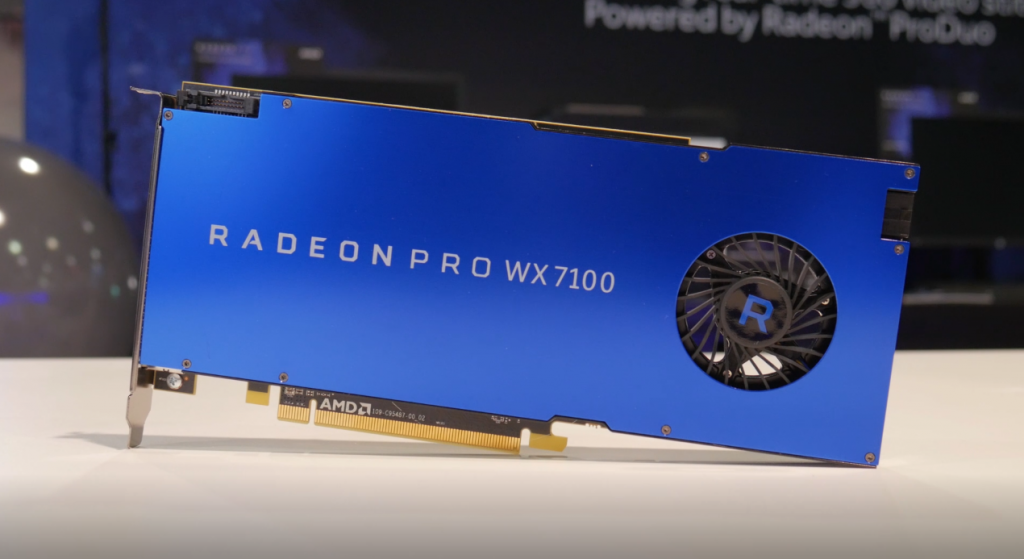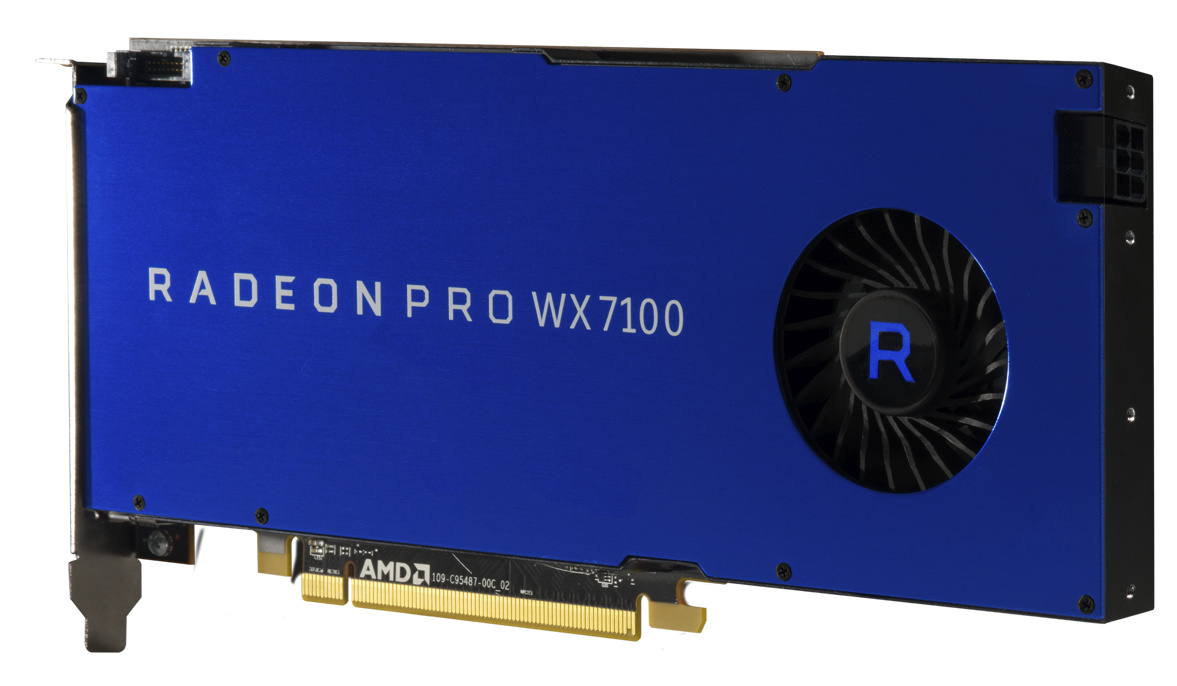

It’s common knowledge in the PC builder community that there are different types of GPUs for different tasks. Gamers, in particular, will be familiar with AMD’s mainstream Radeon RX 400/500 offerings, and the enthusiast grade Radeon RX Vega GPUs.
AMD also offers a comprehensive family of professional workstation GPUs, which were branded as FirePro up until 2016. Since then, AMD’s entire workstation GPU family was refreshed as the Radeon Pro series, powered by the new Polaris and Vega architectures. This was aimed to simplify the choices for customers – Radeon RX for gamers, and Radeon Pro for professionals.
The Radeon Pro WX 7100 is a supremely capable professional card for VR design, or any other type of industrial workflow you can throw at it. It isn’t the most powerful professional card AMD makes, but the Radeon Pro WX 7100 has a major advantage over its higher end Radeon Pro siblings. AMD’s Radeon Pro WX 7100 sports a single-slot form factor, which means that it is physically compact enough to occupy only one PCI slot bracket in a chassis. (You’ll still want to make sure it’s plugged into a PCIe x16 bus.) This makes it an ideal solution for smaller form factor workstations, and is a huge plus when a workstation might need many additional PCI add-in cards installed.
Let’s start off by taking a look at how BluePrint Automation (BPA) leveraged the capabilities of the Radeon Pro WX 7100 in the real world. Once we understand “what” you can do with a high quality workstation GPU, we’ll jump into the Radeon Pro WX 7100’s tech specs to learn a little more about the “why.”
Radeon Pro Use Case: BluePrint Automation with SOLIDWORKS
 So there’s this company out there called BluePrint Automation. They’re pretty good at what they do, but it’s something that you or I (at least, until I started writing this article) might not really ever think about. They make automated packaging machines for foodstuff production lines. Have you ever enjoyed a bag of chips? How about your favorite snack cake? Well, there’s a good chance that a BPA-designed machine helped get those delicious little morsels of carbs and fats into packaging.
So there’s this company out there called BluePrint Automation. They’re pretty good at what they do, but it’s something that you or I (at least, until I started writing this article) might not really ever think about. They make automated packaging machines for foodstuff production lines. Have you ever enjoyed a bag of chips? How about your favorite snack cake? Well, there’s a good chance that a BPA-designed machine helped get those delicious little morsels of carbs and fats into packaging.
The machines BPA makes aren’t just a conveyor-belt and a motor. BPA’s custom-built production lines incorporate cutting edge robotic technologies that can wrap around, pick-up and place objects, and even have some level of machine vision. That means servos, housings for electronic components, and lots of precision moving parts.
To develop devices this complex, BPA engineers needed hardware capable of supporting SOLIDWORKS 2017 in order to ensure accurate visualization of their 3D designs. AMD’s Radeon Pro WX 7100 delivered not only the necessary graphical performance to drive traditional design visualization on monitors, it also ample performance to enable immersive VR visualization using Unreal Engine. In addition to graphics hardware, “Radeon Pro” also encompasses a host of software solutions to aid in design workflows. One of these is the free Radeon ProRender Game Engine Importer, which BPA took full advantage of to easily transfer its SOLIDWORKS designs directly into Unreal Engine for an interactive VR experience.
With this CAD-to-VR workflow, BPA engineers were able to examine human-scale prototypes up close, with observable changes happening in real-time, as fast as a CAD user could update the model. This approach to product development allowed BPA’s team to easily and preemptively examine aspects like ergonomics and ease-of-service. Moreover, all of this occurred before so much as a dollar or a minute was spent on constructing physical prototypes.
Implementing all this VR hardware proved to have an additional cost-saving benefit for BPA. It turns out that shipping a workstation tower and a VR headset to a trade show is a lot less expensive than several hundred pounds of industrial machinery. Through Radeon Pro-powered VR, BluePrint Automation discovered the ability to demonstrate any number of equipment designs, while saving heavily on shipping and setup costs.
Radeon Pro WX 7100 Tech Specs

Like most of the current Radeon Pro WX family, (exceptions being the two top dogs, the WX 9100 and Radeon Pro SSG, which uses the latest ”Vega” GPU architecture from AMD) the WX 7100 is based on AMD’s Polaris microarchitecture, which is also known as 4th gen GCN (Graphics Core Next).
The list of features on the WX7100 is pretty expansive, so here’s a bullet point rundown of some of the most important specs:
8GB DDR5 VRAM
256-Bit Memory INterface
4x Displayport Outputs (Displayport 1.4 compliant)
2304 Stream Processors
36 Compute Units
5.73 TFLOPS Peak Single-Precision Compute Performance
130W Thermal Design Power
Direct Graphics Memory Access
Support for OpenCL, DirectX, Open GL and Vulkan
AMD Eyefinity Multidisplay Technology
Again, it’s worth mentioning that all of this hardware, along with support for various standards, APIs, and protocols, all fits in a single PCI slot form factor. It’s quite possible to build a platform with a staggering amount of compute power, but the real feat of engineering here is fitting so much into such a small package. And you also get an entirely free Radeon Pro Software suite.
Professional Hardware for Professional Applications

Product Photo: Radeon™ Pro WX 710
AMD’s attention to detail doesn’t end with just high-quality silicon and componentry. With the Radeon Pro WX 7100 and the rest of the Radeon Pro lineup, they’ve sought to ensure the maximum level of interoperability with leading CAD, media editing, and other resource-intensive engineering applications. This often means close partnerships with well-known companies like Autodesk, Adobe, and Maxon, all to deliver a glitch-free experience across a wide variety of professional workloads.
This extra level of collaboration is really what sets a workstation grade GPU apart from a consumer-oriented gaming graphics card. AMD has polished the hardware and software for its Radeon Pro cards to achieve optimal performance in a wide range of professional applications and usage scenarios. Moreover, AMD has ensured through this process that its professional GPUs, and their drivers, are certified with leading professional-use software vendors for compatibility. Of course, AMD realizes that 3D artists and CAD engineers like to play games too. To that end, all of its Radeon Pro GPUs are more than capable of loading drivers meant for gaming via a nifty feature built right into the Radeon Pro Settings control panel.
Another key differentiator has to do with physical reliability. Workstation GPUs are engineered with a longer lifespan than consumer cards, as GPUs crunching the numbers on medical imaging data or rendering 3D assets (prior to public-facing optimizations) are much more taxing than even the most graphically-intense AAA gaming title. To put this in perspective, over a long weekend the average gamer might use a gaming GPU at significant capacity for several hours at most. Even the most hardcore players need to stop to eat, sleep, and take the occasional mental break. Plus, very few games will put tremendous strain on a graphics card 100% of the time. On the opposite end of the spectrum, a GPU serving in a CGI render farm could be used for dozens of hours over the same period of time. This sustained stress is wear-and-tear for any computer component or electronic device. The Radeon Pro WX 7100, along with its Radeon Pro siblings, are purposely designed for these harsher environments.
Finally, a key quality of a professional-use GPU has little to do with the hardware itself, and more to do with the support behind that hardware. For all of its workstation cards, AMD offers 24/7 technical support. And although Radeon Pro cards are designed for durability and long lifespan, they also carry a 3-year standard limited warranty and an additional free 7-year extended limited warranty for customers who purchase the retail version of the cards.
AMD Radeon Pro & the WX 7100
With the Radeon Pro WX 7100, and indeed the whole Radeon Pro lineup, AMD looks set to deliver workhorse GPUs for any professional application. The Radeon Pro WX 7100 in particular unleashes the limitless possibilities offered by the integration of VR into design and development in an extremely slim design.
AMD’ Radeon Pro series offer everything the discerning professional would want in a livelihood-earning piece of hardware: Exacting attention to detail, a focus on certifiable compatibility with leading software for engineering and media spaces, and robust durability and lifespan backed by round-the-clock support.
This article is sponsored content, brought to you by AMD.
